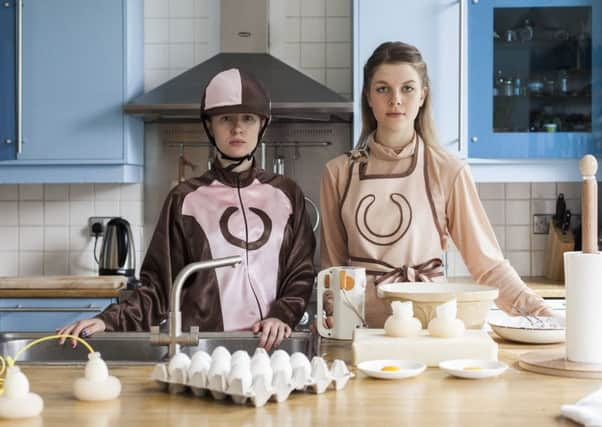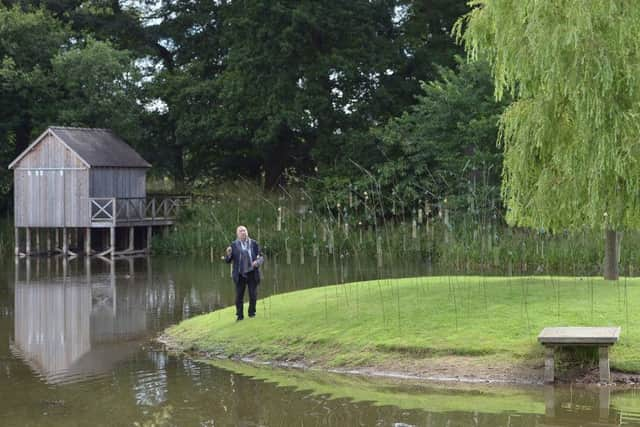Arts review: Edinburgh Art Festival


Nothing stays still forever. In 2012 the artist Tania Kovats created a new work, entitled Rivers, which encouraged the owners of Jupiter Artland, Nicky and Robert Wilson, to develop a large pond at their outdoor sculpture park. One sunny day during the Edinburgh Art Festival that year I watched in alarm as the performance artist Nic Green hurled herself unexpectedly into the water. Later that afternoon I sat in a rowing boat as she pushed it from below, taking a group of us from the shore to the small island at the lake’s centre.
At this year’s EAF that manoeuvre would be impossible. Thanks to the artist Christian Boltanski the island is now a shrine of shimmering movement and sound created by the most economical of means. Entitled Animatas (***) it is a simple enough idea: dozens of tiny bells on sticks, each appended with a simple sheet of clear plastic. In the breeze, the tinkling of the bells is accompanied by a stuttering light that is reflected in the water below. Boltanski, a big beast of French contemporary art, has laid out everything in a celestial pattern, reflecting the night sky on the date of his birth in 1944. It might seem like frightful vanity but the work anticipates loss too. It was originally sited in the Atacama Desert, a place of pilgrimage for those remembering the Chileans who disappeared during the Pinochet regime. In the Steading Gallery, a white-suited official ushers you into booth where your heartbeat is recorded for posterity. Boltanski is hoarding them in a deserted building in a Japanese island.
Advertisement
Hide AdAdvertisement
Hide AdUpstairs Glasgow artist Hayley Tompkins’s show Myth Cart (****) has filled the gallery with a wonderful new suite of poured paintings and collages bringing urban detritus into the pristine rural setting with breezy and improvisatory charm. Under the tin roof, her works reference metal band saws and industrial equipment. An iPad is wedged in a galvanised tin bucket, showing a short film in which the artist browses through a glossy magazine to an ambient soundtrack of clicks and flicks. She has even extended her painting show beyond the small attic space and out on to the corrugated roof, placing a further corrugated layer, painted in bright colours of red, blue and yellow.


In any given arts space, you see not just the work in front of you but what is underneath and what went before. That seems particularly true of Edinburgh’s Inverleith House, which, because of its historical status and its lovely domestic scale, has been much less susceptible to the volatile transformations that large institutions seem prone to. One of those layers is a simple text work by Douglas Gordon. The words I still believe in miracles have adorned the gallery wall since placed there in 2005. The work now lends its name to a celebratory exhibition (****) marking three decades of the gallery with curator Paul Nesbitt at the helm. The show is a salutary reminder of just how diverse and how hugely influential its programme has been. A gorgeous marble statuette (half girl, half plant) by Louise Bourgeois sits next to works by the late pop artist Richard Hamilton and a stunning suspended sculpture of crushed cellophane by Karla Black is splashed with green paint bringing the Royal Botanic Garden indoors. Upstairs, works by Cathy Wilkes and Victoria Morton share space with an agglomeration of polystyrene, paint and metal by Isa Genzken, an older artist with whom their work has long seemed to be in direct conversation. What is striking is Inverleith’s outward-looking attitude. Its internationalism, though largely transatlantic and in recent times rather masculine, now seems actively defiant in a time of bemusingly parochial programmes at some Scottish cultural institutions. Nesbitt’s vision has always been tempered by the gallery’s other strand of fine botanical and historical displays curated by Henry Noltie and this show, by including historical material, also reminds us that the gallery’s conversation between contemporary art and nature succeeds because it is not about woolly notions of the environment, but about research, the visualisation of complex ideas, and the persistence of endeavour by individual outliers in both scientific and artistic culture.
At Stills, a marvellous and rewarding exhibition is dedicated to the endeavour of a remarkable individual the late Jo Spence (****) a working class girl who grew up to be one of the most important woman photographers and feminist artists of the 1970s and 80s. In her lifetime Spence was often marginalised, but she turned her life experience into an exemplary tale of self-discovery, angry politics and optimistic transformation. Spence, who lived through and unsparingly recorded breast cancer but died of leukaemia in 1992, is represented by a selection of her many series of works about identity politics. It is an untrammelled joy to see the prescient degree show she presented as a mature student with fellow students the Polysnappers, musing upon crap sexist advertising slogans, page three models and the marriage of Princess Diana. It is a masterclass in the politics of the image and as relevant now as when created in 1981.
If much of EAF this year is about the layers of the past then Platform (***), the festival’s annual showcase of emerging artists, is reassuringly in the present tense. Jack Saunders’ video work is hypnotically addictive, especially nauseating footage of a sausage-making machine. Paloma Proudfoot and Aniela Piasecka have created an installation of delicate ceramic bowling balls but they will smash them through a series of iconoclastic performances. In time, everything changes.
• The Edinburgh Art Festival runs until 28 August, www.edinburghartfestival.com